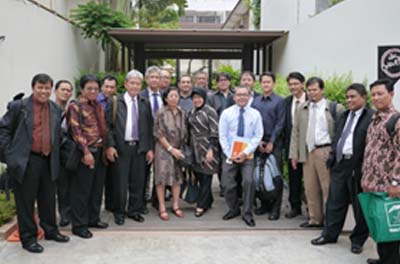Improving Logistics in Indonesia

Key Contact
Henri Mickel Sandee
Start Date
End Date
Funding Amount
$ 26,385
Knowledge-providing Countries
Knowledge-receiving Countries
Summary
Indonesia faced deficiencies in trade and logistics that increased the costs of transporting goods and threatened its competitiveness. The Government, with support of the World Bank, sought to develop and implement a strategy to improve logistics. In 2009, Indonesian officials participated in a Bank-supported study tour to Thailand, which had implemented a five-year logistics strategy and was a strong performer on the World Bank’s Global Logistics Index. The visit focused on how to engage multiple stakeholders in developing a long-term strategy and on short-run approaches for improving the efficiency of ports. After developing a draft strategy, the Government in 2012 supported a second visit to Thailand, partly financed by the South-South Facility, to build buy-in on this strategy and capacity to implement it, while deepening learning on key topics, particularly the linkages between dry and sea ports.
During five days in April 2012, 25 delegates from Indonesian ministries, associations, universities, private companies and the World Bank visited Bangkok to participate in meetings and visit two Thai ports. Delegates learned about the challenges that Thailand faced in implementing its strategy and the role of the Thai National Logistics Council in coordinating it. Delegates received feedback on Indonesia’s strategy from Thai counterparts and the United Nations Economic and Social Commission for the Asia and Pacific (UNESCAP), which was assisting Asian countries in port reform. Participants learned how to monitor logistics and discussed issues in cross-border trade. The delegation traveled to ports in Lat Krabang and Laem Chabang to learn about reducing ship congestion, improving the transfer of shipping containers to dry ports, and applying public-private partnerships.
Besides increasing delegates’ know-how, the visit strengthened their skills and commitment to implement Indonesia’s logistics strategy. Delegates prepared memos on lessons learned, and Indonesia’s Deputy Minister for Industry and Trade shared a summary of these lessons with the Indonesian Cabinet, highlighting the importance of engaging multiple stakeholders in executing the strategy, strengthening logistics’ monitoring, and coordinating sea and dry port development. Partly driven by this exchange, Indonesia’s Presidential Office issued a decree outlining the country’s logistics strategy and a detailed action plan.
The visit, which was part of a Bank technical assistance program, helped stimulate additional South-South learning with Thailand and other countries. According to one delegate, the exchange also demonstrated that gains in logistics do not always require substantial investments in infrastructure, but may be achieved through regulatory reform.
Beneficiaries / Participants
Indonesia has faced deficiencies in the coverage and operations of its ports, transport, and other infrastructure supporting the import, export, and domestic distribution of goods. This problem was reflected in its weak performance in the World Bank Logistics Index, and—more pointedly— the higher costs of importing an orange to Jakarta from Indonesia’s outlying islands than from China. The Indonesian government took initial steps in 2009 to develop an approach for a logistics strategy, and sought assistance from the Bank to learn from good practices in other countries.
The World Bank, which was supporting trade programs in Indonesia through the Multi-Partner Trust Fund for Trade and Investment Climate, proposed that Indonesian authorities learn from Thailand, which was strong performer in the Bank’s Logistic Index and had successfully implemented a five-year logistics strategy. In 2009, the Bank supported an initial study tour of Indonesian officials to Thailand financed by a regional trust fund. Through this visit, officials learned about approaches for designing a logistics strategy, engaging multiple stakeholders in the strategy development process, and improving the efficiency of ports. Once officials had developed a strategy, the Bank organized a second study tour to Thailand in 2012 to continue learning on logistics and port reforms, enhance buy-in on this strategy and capacity to implement it, and identify next steps. The Indonesians’ demonstrated their commitment to this second visit by their willingness to translate the strategy into English, and the strong interest of Deputy Ministers to participate.
Moving forward
The exchange was part of Indonesia’s multi-year program to improve logistics, which has been supported by the Bank and other partners, notably through the Multi-Partner Trust Fund for Trade and Investment Climate. According to an Indonesian professor who participated in the visit, a key longer-term lesson is that gains in logistics do not necessarily require investments in infrastructure, but can be driven by regulatory reform. Indonesia has since taken steps to engage multiple stakeholders in logistics reform and to embrace a system of monitoring and evaluation. For example, Indonesian professors developed a State of Logistics Report, based on a similar product in Thailand, which includes a chapter on estimating logistics costs as a percentage of GDP.
Besides Thailand, Indonesia has also reached out to other countries to learn about logistics issues. For instance, Indonesia has engaged in exchanges with Japan and the Netherlands to learn about the establishment and operations of dry ports.

 China
China Colombia
Colombia Denmark
Denmark India
India Indonesia
Indonesia Mexico
Mexico Russian Federation
Russian Federation Spain
Spain United Kingdom
United Kingdom